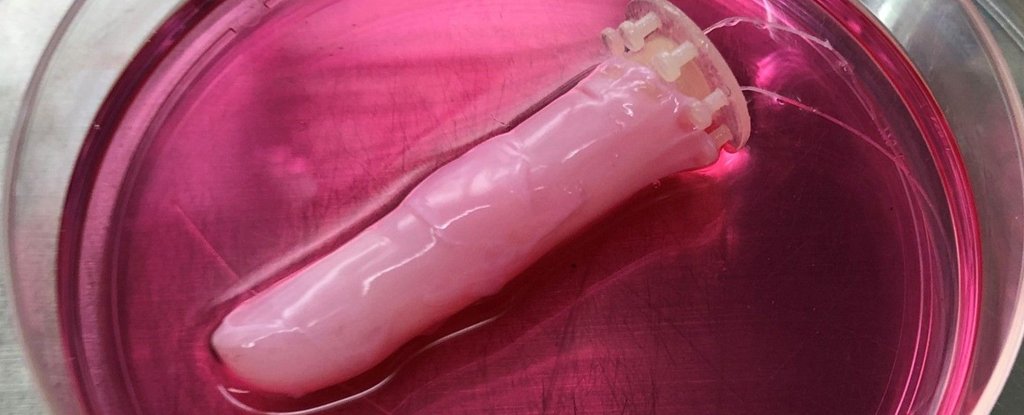Products You May Like
From Talos, the giant bronze automaton who guarded the princess Europa in ancient Greek myths, to Cylons and Terminators, the idea of artificial humans has both fascinated and creeped us out for centuries.
Now, we’re closer than ever to making a robot look remarkably like a human, with the development of living robot skin. This icky-looking substance is water repellent, self healing, and has a texture just like our own skin.
Because it’s actually made of human skin cells.
“I think living skin is the ultimate solution to give robots the look and touch of living creatures since it is exactly the same material that covers animal bodies,” said University of Tokyo tissue engineer Shoji Takeuchi.
The researchers have successfully coated a three-jointed, functioning robot finger with a prototype of this lab-grown skin.
“The finger looks slightly ‘sweaty’ straight out of the culture medium,” says Takeuchi. “Since the finger is driven by an electric motor, it is also interesting to hear the clicking sounds of the motor in harmony with a finger that looks just like a real one.”
Previous attempts to graft skin onto robotic surfaces have proved challenging, so University of Tokyo tissue engineer Michio Kawai and colleagues took an approach that allows the skin to mold itself onto the device.
“It is difficult to cut, glue, or suture the endpoints of skin equivalent without damaging the soft, fragile tissue,” Kawai and team explain in their paper.
Instead, they dipped the robotic structure into a solution of collagen and dermal fibroblast – cells that produce the proteins that form our skin’s structural matrix. These are the main parts of skin’s connective tissue.
They then coated this primer layer with epidermal cells (keratinocytes), the main component of our outermost skin layer. Without this extra layer, the material would lack water repellence of the same kind that animals have.
In the footage below, the electrostatically charged polystyrene bead sticks to the finger without an epidermis, making it harder for the finger to manipulate.
While the gooey material could handle repeated stretching and contracting of the robotic finger’s movements, it is still much weaker than human skin. The team suggests a greater concentration of collagen in the initial solution as well as further maturation of the cells may improve this.
Remarkably, the artificial skin can also be healed with a collagen bandage, which the living cells take and integrate into their system to help fill in the damage.
While the results are quite amazing, the lab-grown tissue is still very limited. It cannot last long outside its nutrient solution – just like our skin, it requires a consistent supply of water to avoid drying out, but the artificial skin layers lack the complicated components of circulatory and sweat gland systems to supply such hydration.
“Building perfusion channels within and beneath the dermis equivalent to mimic blood vessels to supply water, as well as the integration of sweating glands in the skin equivalent, are important directions for future research,” Kawai and colleagues write.
They also propose adding ‘nerves’ and sensors so that lab-made skin can be multi-talented just like ours – serving as both protection and a sensory organ.
“We are surprised by how well the skin tissue conforms to the robot’s surface,” says Takeuchi. “But this work is just the first step toward creating robots covered with living skin.”
The researchers hope making robots appear more human will help us relate to and like them more, so they can better communicate with us, serving in the medical, care, and service industries. (That is, of course, if we can progress artificial humanoids beyond the uncanny valley.)
“These findings show the potential of a paradigm shift from traditional robotics to the new scheme of biohybrid robotics that leverage the advantages of both living materials and artificial materials,” the researchers conclude.
Their research was published in Matter.
